In the vast world of pastries, the old fashioned donut stands out for its unique texture and nostalgic appeal. Unlike its yeast-raised counterparts, this cake-style donut boasts a crispy exterior and tender crumb, making it a favorite among donut enthusiasts. But what exactly sets the old fashioned donut apart, and why does it continue to captivate taste buds?
Let’s delve into the history, preparation methods, and variations of this classic treat, ensuring a comprehensive understanding of its enduring popularity.
What Is an Old Fashioned Donut?
 An old fashioned donut is a type of cake donut characterized by its cracked surface and slightly crispy edges. Traditionally made without yeast, it relies on chemical leaveners like baking powder to achieve its rise. This results in a denser texture compared to yeast donuts, offering a satisfying bite with every mouthful.
An old fashioned donut is a type of cake donut characterized by its cracked surface and slightly crispy edges. Traditionally made without yeast, it relies on chemical leaveners like baking powder to achieve its rise. This results in a denser texture compared to yeast donuts, offering a satisfying bite with every mouthful.
The signature cracks on its surface aren’t just for aesthetics; they allow glazes and toppings to seep in, enhancing the flavor profile. Whether enjoyed plain or adorned with a sugary glaze, the old_fashioned_donut offers a delightful contrast of textures and flavors.
A Brief History Of Old Fashioned Donut
The origins of the old_fashioned_donut trace back to the 19th century. While early donuts were primarily yeast-based, the advent of chemical leaveners introduced a new style of donut-making. This innovation led to the creation of cake donuts, with the old fashioned variety emerging as a popular choice due to its unique texture and ease of preparation.
Over time, the old_fashioned_donut became a staple in bakeries across the United States, cherished for its simplicity and rich flavor. Its enduring presence in modern bakeries attests to its timeless appeal.
Old Fashioned Donut Ingredients and Preparation
Creating the perfect old_fashioned_donut involves a blend of simple ingredients and precise techniques. Here’s a breakdown of the essentials:
Primary Ingredients:
-
Flour: Provides the structural base.
-
Sugar: Adds sweetness and aids in browning.
-
Eggs: Bind the ingredients and contribute to richness.
-
Butter: Enhances flavor and tenderness.
-
Sour Cream or Buttermilk: Introduces moisture and a slight tang, contributing to the donut’s unique taste.
-
Baking Powder: Acts as the leavening agent.
-
Nutmeg: Offers a subtle warmth and depth of flavor.
Preparation Steps:
-
Mixing: Combine the dry ingredients in one bowl and the wet ingredients in another. Gradually incorporate the dry mix into the wet, forming a cohesive dough.
-
Chilling: Refrigerate the dough to make it easier to handle and shape.
-
Shaping: Roll out the dough and cut into rings using a donut cutter.
-
Frying: Heat oil to the appropriate temperature and fry the donuts until golden brown.
-
Glazing: Once cooled slightly, dip the donuts into your preferred glaze or sprinkle with sugar.
This method ensures a crispy exterior and moist interior, capturing the essence of the classic old fashioned donut.
Variations to Explore
While the traditional old_fashioned_donut is delightful on its own, various adaptations have emerged over the years:
-
Chocolate Old Fashioned Donut: Incorporates cocoa powder into the batter, offering a rich, chocolatey twist.
-
Glazed Old Fashioned Donut: Dipped in a sweet glaze, enhancing its sweetness and adding a glossy finish.
-
Maple Glazed: Topped with a maple-flavored glaze, introducing a distinct, earthy sweetness.
-
Cinnamon Sugar: Coated in a blend of cinnamon and sugar, providing a warm, spicy kick.
These variations cater to diverse palates, ensuring there’s an old_fashioned_donut for everyone.
While indulgent, it’s essential to be aware of the nutritional aspects of old_fashioned_donuts:
-
Calories: Approximately 308 per donut.
-
Fat: Around 21 grams, with 10 grams of saturated fat.
-
Carbohydrates: Roughly 57 grams.
-
Protein: About 4 grams.
Note: Nutritional values can vary based on specific recipes and serving sizes.
Homemade Old Fashioned Donut Recipe

For those eager to recreate this classic at home, here’s a straightforward recipe:
Ingredients:
-
2 1/4 cups all-purpose flour
-
1 1/2 teaspoons baking powder
-
1/2 teaspoon salt
-
1/2 teaspoon ground nutmeg
-
1/2 cup sugar
-
2 tablespoons unsalted butter, softened
-
2 large egg yolks
-
1/2 cup sour cream
-
Oil for frying
Instructions:
-
Combine Dry Ingredients: In a bowl, whisk together flour, baking powder, salt, and nutmeg.
-
Cream Butter and Sugar: In another bowl, beat sugar and butter until light and fluffy.
-
Add Egg Yolks: Incorporate the egg yolks into the butter mixture.
-
Mix in Sour Cream: Add sour cream, blending until smooth.
-
Combine Mixtures: Gradually add the dry ingredients to the wet mixture, forming a soft dough.
-
Chill Dough: Cover and refrigerate for at least an hour.
-
Shape Donuts: Roll out the dough and cut into rings.
-
Fry: Heat oil to 325°F (163°C) and fry donuts until golden brown.
-
Cool and Glaze: Allow to cool slightly before glazing or sugaring.
Enjoy your homemade old_fashioned_donuts fresh for the best taste and texture.
Conclusion
The old_fashioned_donut, with its rich history and delightful texture, remains a beloved treat for many. Whether enjoyed in its traditional form or through various adaptations, its charm is undeniable. By understanding its origins, preparation methods, and variations, one can truly appreciate this timeless pastry.
FAQs
1. What distinguishes an old fashioned donut from other types?
Old fashioned donuts are cake-style, made without yeast, resulting in a denser texture and signature cracked surface.
2. Can I bake old fashioned donuts instead of frying?
While traditionally fried, baking is possible. However, the texture may differ, lacking the characteristic crispiness.
3. How should I store leftover donuts?
Store in an airtight container at room temperature for up to two days. For longer storage, consider freezing.
4. Are there gluten-free versions of old fashioned donuts?
Yes, by substituting with gluten-free flour blends, though texture and flavor may vary.
5. Can I use yogurt instead of sour cream?
Absolutely. Yogurt can be a suitable substitute, offering a similar tang and moisture content.






